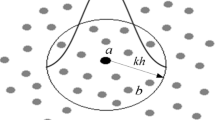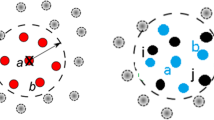Abstract
This paper deals with a two-dimensional numerical model based on the smoothed particle hydrodynamics (SPH) technique for the evaluation of the concentration field of pollutants in water. A SPH model is formulated to solve the fickian diffusion equation applied to pollutants with the same density as the water. A lagrangian SPH formalism of the advective diffusion equation is also developed for pollutant-water, taking into account the effects of molecular diffusion and natural advection induced by differences between the fluid densities. These equations are coupled with the fluid mechanics equations. Attention is paid to the numerical aspects involved in the solution procedure and to the optimization of the model parameters. Environmental engineering problems concerning diffusion and natural advection phenomena occur in the presence of a pollutant in still water. Numerical tests referring to a strip and a bubble of contaminant in a water tank with different initial concentration laws have been carried out. The results obtained by the proposed SPH models are compared with other available SPH formulations, showing an overall better agreement with standard analytical solutions in terms of spatial evolution of the concentration values. Capabilities and limits of the proposed SPH models to simulate advective diffusion phenomena for a wide range of density ratios are discussed.
Similar content being viewed by others
References
Fick AE (1885) Poggendorffs Annelen der Physic 94: 1–59
Socolofsky SA, Jirka GH (2004) Special topics in mixing and transport processes in the environment. Texas AM University, College Station, pp 1–172
Gingold R, Monaghan JJ (1977) Smoothed particle hydrodynamic: theory and application to non-spherical stars. Month Notice R Astron Soc 181: 375–389
Monaghan JJ (1994) Simulating free surface flows with SPH. J Comput Phys 110: 399–406
Colagrossi A, Landrini M (2003) Numerical simulation of interfacial flows by smoothed particle hydrodynamics. J Comput Phys 191: 448–475
Panizzo A (2004) Physical and numerical modelling of subaerial landslide generated waves, PhD Thesis, University of L’Aquila, pp 1–131
Dalrymple RA, Rogers BD (2006) Numerical modeling of water waves with the SPH method. Coast Eng 53(2–3): 141–147
Aristodemo F, Marrone S, Panizzo A, Capone T, De Girolamo P, Veltri P (2008) A lagrangian SPH model to simulate a non-steady flow on a triangular sill. Proceedings of 3rd SCACR international short course and workshop on applied coastal research, University of Salento, pp 240–251
Cleary PW, Monaghan JJ (1999) Conduction modelling using smoothed particle hydrodynamics. J Comput Phys 148: 227–264
Zhu Y, Fox PJ (2001) Smoothed particle hydrodynamics model for diffusion through porous media. Trasp Porous Media 43: 441–471
Zhu Y, Fox PJ (2002) Simulation of pore-scale dispersion in periodic using smoothed particle hydrodynamics. J Comput Phys 182: 622–645
Tartakovsky AM, Meakin P (2005) A smoothed particle hydrodynamics model for miscible flow in three-dimensional fractures and the two-dimensional Rayleigh-Taylor instability. J Comput Phys 207: 610–624
Tartakovsky AM, Meakin P, Scheibe TD, West RME (2007) Simulations of reactive trasport and precipitation with smoothed particle hydrodynamics. J Comput Phys 222: 654–672
Manenti S, Di Monaco A, Gallati M, Sibilla S, Agate G, Guandalini R, Maffio A (2009) Simulating rapid sediment scour by water flow with SPH. Proceedings of 4th SPHERIC workshop, Nantes, pp 145–149
Monaghan JJ (2005) Smoothed particle hydrodynamics. Report Prog Phys 68: 1703–1759
Monaghan JJ, Lattanzio JC (1985) A refined particle method for astrophysical problems. Astron Astrophys 149: 135–143
Batchelor GK (1967) An introduction to fluid dynamics. Cambridge University Press, Cambridge, pp 1–615
Morris JP (1996) Analysis of smoothed particle hydrodynamics with applications, PhD Thesis, Monash University, pp 1–169
Morris JP, Zhu Y, Fox PJ (1997) Modeling low Reynolds number incompressible flows using SPH. J Comput Phys 136: 214–226
Brookshaw L (1985) A method of calculating radiative heat diffusion in particle simulations. Astron Soc Aust 6: 207–210
Fischer HB, List EG, Koh RCY, Imberger J, Brooks NH (1979) Mixing in inland and coastal waters. Academic Press, New York, pp 1–483
Monaghan JJ (2006) Time stepping algorithms for SPH proceedings of 1st SPHERIC workshop, Rome, pp 1–13
Shepard D (1968) A two dimensional function for irregularly space data. Proceedings of ACM national conference, pp 517–524
Aristodemo F, Federico I, Veltri P (2009) Modellazione numerica SPH applicata a problemi di idraulica ambientale, Atti del Terzo Convegno Nazionale di Idraulica Urbana, Milano, pp 1–12 (in italian)
Author information
Authors and Affiliations
Corresponding author
Rights and permissions
About this article
Cite this article
Aristodemo, F., Federico, I., Veltri, P. et al. Two-phase SPH modelling of advective diffusion processes. Environ Fluid Mech 10, 451–470 (2010). https://doi.org/10.1007/s10652-010-9166-z
Received:
Accepted:
Published:
Issue Date:
DOI: https://doi.org/10.1007/s10652-010-9166-z




